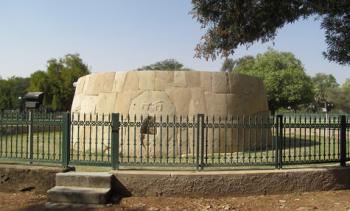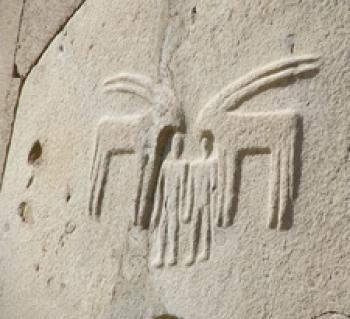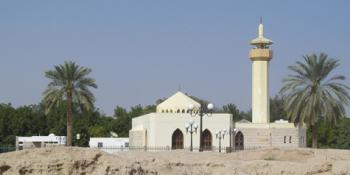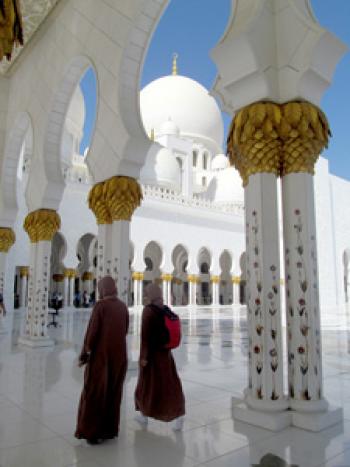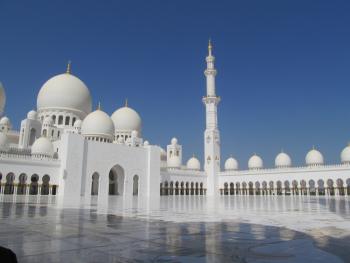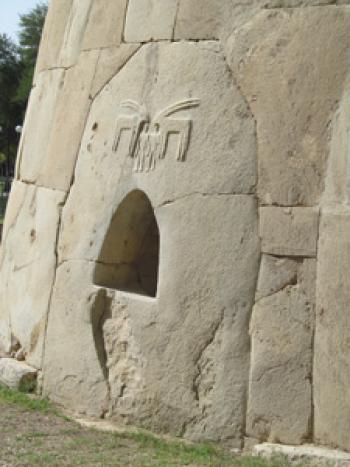Hili — Bronze Age settlement in Abu Dhabi
This item appears on page 54 of the December 2018 issue.
Late one February afternoon in 2018, my husband, Paul, and I arrived at Hili, an archaeological site 6 miles north of the oasis city of Al Ain in Abu Dhabi.
At first, we were confused. What we saw before us was different from most of the archaeological sites we had visited around the world, including those we had just visited a week or two before in Oman, Abu Dhabi's neighbor to the southeast.
At Hili, it is not just rock or stone remnants from the past lying on the ground. When we entered the site, we saw neatly manicured lawns, trees, a children's play area and a white mosque. Where were the ruins of the long-gone culture we had come to see?
The answer is in the site's official name: Hili Archaeological Park. The archaeological site has been merged into the surrounding park, creating a space more accessible and, hopefully, more usable to both visitors and the people who live nearby.
Umm al-Nar culture
We had come to Al Ain, 100 miles east of Abu Dhabi city, to visit Hili, the largest Bronze Age site in the United Arab Emirates and also one of the oldest. Hili belongs to the Umm al-Nar culture, which flourished in this part of the Arabian Peninsula in the 3rd millennium BC, roughly between 2600 and 2000 BC.
The inhabitants of ancient Hili cultivated date palms, wheat and barley, kept herds of sheep, goats and cattle and may have hunted gazelle and oryx. They developed a complex irrigation system for their crops. They built in stone and brick and also traded with other settlements.
Hili One
One of the earliest sections of Hili is a large, partially excavated area of mud-brick buildings with a tower that was once surrounded by smaller structures. Appropriately, it's called Hili 1 because of its age, and it may have been constructed as early as 2900 BC, with successive construction phases over the following 1,000 years.
Hili 10 is another mud-brick construction, a building from 2500 to 2000 BC that may have been part of a larger settlement or a larger group of buildings. After about 2000 BC, it probably lay unused for 1,000 years until reoccupied in the early 1st millennium BC.
Grand Tomb
The highlight at Hili is the Grand Tomb adjacent to Hili 1. It's a magnificent circular structure with a diameter of 40 feet and a height of 13 feet.
Built of carefully cut smooth stone fitted closely together, it had entrances on both its north and south sides. The Grand Tomb served as a communal burial chamber during the second half of the 3rd millennium BC, roughly 2500 to 2000 BC.
Over both tomb entrances, animal and human reliefs have been carved. Look for the figure of the oryx, an antelope once common in the region but now, sadly, dwindling in numbers despite its protected status.
The inside of the tomb was divided into chambers to hold the bodies of the dead. At some point after interment, the bones were probably removed and placed in pit graves. Burial goods were placed in the tombs alongside the dead. These included pottery and personal ornaments, much of it now on display in the Al Ain National Museum, in the center of the city on Zayed bin Sultan Street.
Nearby is a tomb similar to the Grand Tomb except that it has not been reconstructed. With its dome missing, visitors can peer inside from outside a protective fence to see the chambered interior that held the dead.
Later Hili
Even after Hili's apogee, people continued to live in the area. Nearby is a small Iron Age village of mud-brick houses dating from about 1000 BC along with an underground water-irrigation system called a falaj that shows the level of engineering skill reached 3,000 years ago.
As Paul and I were leaving the archaeological park, the call to prayer resounded from the mosque. Inhabitants from the neighborhood began to stream through the park toward the mosque, passing tombs of ancestors 120 generations removed. Now, that's a thought.
Other things to do in Abu Dhabi
Abu Dhabi, one of the seven emirates comprising the United Arab Emirates, is rich in things to see and do. Among my three favorite "must do's" is visiting the Sheikh Zayed Grand Mosque, where Sheikh Zayed bin Sultan al Nahyan, first president of the UAE, lies in a mausoleum just outside the mosque.
The Grand Mosque, open to non-Muslims except during prayer times, is stunning — multiple domes, pillars and minarets, the world's largest carpet, enormous gilt chandeliers, and floral designs composed of semiprecious stones decorating floors, pillars and walls.
Then there's the new Louvre Abu Dhabi museum (phone 971 600 56 55 66, www.louvreabudhabi.ae), opened in November 2017 on Saadiyat Island, displaying artifacts from around the world and from all time periods. Included is a double-headed human figure from about 6500 BC. It was discovered in Jordan and is supposedly one of the earliest sculptures in human history.
Also not to be missed is the over-the-top Emirates Palace Abu Dhabi (West Corniche Road; phone 971 2 690 9000, www.kempinski.com/en/abudhabi/emirates-palace), where a cup of cappuccino dotted with flecks of 24k gold can be enjoyed in the hotel's cavernous lobby café. An elegant, complete afternoon tea is served there as well.
If you go…
Hili Archaeological Park is open from 4 to 11 p.m., Saturday to Thursday, and from 1 to 11 p.m. Friday. (It is wise to check these hours in advance if traveling from Abu Dhabi city.)
We stayed at the Shangri-la Hotel in Abu Dhabi (Khor al Maqta, Qaryat al Beri; phone [971 2] 509 8888, www.shangri-la.com/abudhabi/shangrila). Our Horizon Club room came with a small terrace overlooking the Maqta Waterway, with a view of the majestic Sheikh Zayed Grand Mosque just beyond.
We dined at two of the Shangri-la's restaurants: Hoi An, serving Vietnamese food, and Bord Eau, specializing in French cuisine. We recommend both highly. Dinner for two at Hoi An, including appetizers, main courses, desserts, drinks and coffees, cost approximately $120. A complete dinner for two at Bord Eau cost $180.
Room rates at the Shangri-la begin at $286 per night for a deluxe room for two. A Horizon Club Deluxe room will cost you $374 for two, but it comes with access to a members-only lounge serving snacks and drinks. Breakfast is included in both deluxe and Horizon Club rates, which vary depending on the season.

